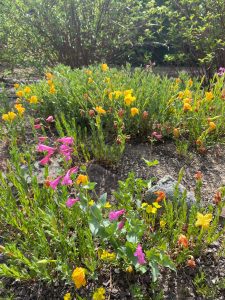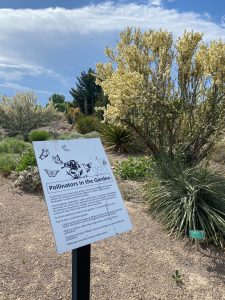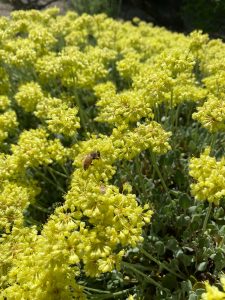Environmentally Savvy Landscaping: Orton Botanical Garden Demonstrates the Beauty of High-Desert Gardens
Located just ten minutes outside of downtown Twin Falls, Orton Botanical Garden is an unusual oasis. As opposed to a burst of green amid the desert, Orton Botanical Garden is a patch of desert amid carefully tended lawns. The garden hums with bees, hummingbirds, butterflies, quail families, and songbirds. It’s obvious that to some inhabitants of the Twin Falls area, this 5-acre lot of land is a refuge amid pavement and Kentucky bluegrass.The plot is a mix of Idaho-native and Great Basin-native grasses, succulents, buckwheats, trees, shrubs, yuccas and more, offering all the inspiration a gardener might need to curate their own environmentally-friendly, resilient garden.  Orton Botanical Garden began as a passion project; after falling in love with the Sonoran Desert of Tucson, Arizona, LaMar Orton and his wife wondered to themselves what sort of drought-tolerant plants they could raise in their home state of Idaho. They later bought the 5-acre plot where the garden resides now, experimenting with bringing up various cold-hardy, dry-weather plants. With the encouragement of groups like Idaho Native Plant Society, the Ortons designated their gardening operation as a formal botanical garden. Today, Orton Botanical’s Mission Statement is to “educate people of all ages and backgrounds about cold-hardy cacti and other succulents, native and drought tolerant plants, environmental health, and resource conservation. The Garden also demonstrates how plants can support and protect pollinators and other wildlife while adding beauty to the landscape.”Should you be so lucky as to tour the garden with LaMar Orton himself, his excitement for the beauty, power, and resilience of these hardy plants are infectious. Among the garden’s highlights is a berm filled with Idaho-native plants, some species of which can found only in the most remote corners of the state. “This buckwheat right here, this one is found only on one hill, a very small little hill in Idaho on the Montana border. It’s one of a number of buckwheats that are endemic to Idaho,” Orton explained. There are other endemic, important Idaho plants, but Orton doesn’t name them all; some are too precious—entrusted to the garden for safekeeping by government land agencies—to reveal their identity. However, by and large, the garden is meticulously labeled so that any visitor can easily begin their own research into native Great Basin plants. Additionally, there’s signage to explain cultural or historical significance of certain plants, as well as examples about their role in the ecosystem.
Orton Botanical Garden began as a passion project; after falling in love with the Sonoran Desert of Tucson, Arizona, LaMar Orton and his wife wondered to themselves what sort of drought-tolerant plants they could raise in their home state of Idaho. They later bought the 5-acre plot where the garden resides now, experimenting with bringing up various cold-hardy, dry-weather plants. With the encouragement of groups like Idaho Native Plant Society, the Ortons designated their gardening operation as a formal botanical garden. Today, Orton Botanical’s Mission Statement is to “educate people of all ages and backgrounds about cold-hardy cacti and other succulents, native and drought tolerant plants, environmental health, and resource conservation. The Garden also demonstrates how plants can support and protect pollinators and other wildlife while adding beauty to the landscape.”Should you be so lucky as to tour the garden with LaMar Orton himself, his excitement for the beauty, power, and resilience of these hardy plants are infectious. Among the garden’s highlights is a berm filled with Idaho-native plants, some species of which can found only in the most remote corners of the state. “This buckwheat right here, this one is found only on one hill, a very small little hill in Idaho on the Montana border. It’s one of a number of buckwheats that are endemic to Idaho,” Orton explained. There are other endemic, important Idaho plants, but Orton doesn’t name them all; some are too precious—entrusted to the garden for safekeeping by government land agencies—to reveal their identity. However, by and large, the garden is meticulously labeled so that any visitor can easily begin their own research into native Great Basin plants. Additionally, there’s signage to explain cultural or historical significance of certain plants, as well as examples about their role in the ecosystem. In the center of the garden is an open lawn of Idaho grass that bows and ripples in the wind. Orton explains that he only mows the lawn come October, as the quail nest in the grass through the summer months.“This was a hayfield when we bought this property. We had only ever seen a quail here once, when this was hay. When we got the garden started, they just started showing up. We’ve had many baby quail born in the garden.” Not long after, a family of four of the stout birds dart across one of the garden’s paths.
In the center of the garden is an open lawn of Idaho grass that bows and ripples in the wind. Orton explains that he only mows the lawn come October, as the quail nest in the grass through the summer months.“This was a hayfield when we bought this property. We had only ever seen a quail here once, when this was hay. When we got the garden started, they just started showing up. We’ve had many baby quail born in the garden.” Not long after, a family of four of the stout birds dart across one of the garden’s paths. It’s not only the quail who thrive in this environment; pollinators flock to Orton Botanical Garden’s blooms. The garden is a designated demonstration garden for the city of Twin Falls—which is both a “Bee City USA” and “Monarch City”—and hosts some 34 species of pollinator-attractant plants. This includes everything from hummingbirds, to wasps, to moths, to good, old-fashioned bumble and honey bees. The flowers almost vibrate, alive with motion.“We have a neighbor down Filer Avenue who has some hives, and he said he sees his bees headed this direction every morning,” Orton laughed. “When he comes by he goes, ‘that’s my bee,’ and ‘that’s my bee!”In addition to offering modeling environmentally-friendly, native landscaping, the garden also offers educational opportunities, hosting classes and bringing in regional experts. The garden is public and non-profit, but does host a plant sale in late May to support their mission. This sale is your chance to take trimmings from the garden itself!The garden is open on Fridays and Saturdays, otherwise by appointment. If you're looking for opportunities to create a water-friendly, pollinator-friendly, wildlife-friendly haven this summer, consider paying the Ortons a visit.
It’s not only the quail who thrive in this environment; pollinators flock to Orton Botanical Garden’s blooms. The garden is a designated demonstration garden for the city of Twin Falls—which is both a “Bee City USA” and “Monarch City”—and hosts some 34 species of pollinator-attractant plants. This includes everything from hummingbirds, to wasps, to moths, to good, old-fashioned bumble and honey bees. The flowers almost vibrate, alive with motion.“We have a neighbor down Filer Avenue who has some hives, and he said he sees his bees headed this direction every morning,” Orton laughed. “When he comes by he goes, ‘that’s my bee,’ and ‘that’s my bee!”In addition to offering modeling environmentally-friendly, native landscaping, the garden also offers educational opportunities, hosting classes and bringing in regional experts. The garden is public and non-profit, but does host a plant sale in late May to support their mission. This sale is your chance to take trimmings from the garden itself!The garden is open on Fridays and Saturdays, otherwise by appointment. If you're looking for opportunities to create a water-friendly, pollinator-friendly, wildlife-friendly haven this summer, consider paying the Ortons a visit.
To get blogs like this delivered straight to your email inbox, and to stay updated on Idaho's environment, sign up for ICL program updates!

